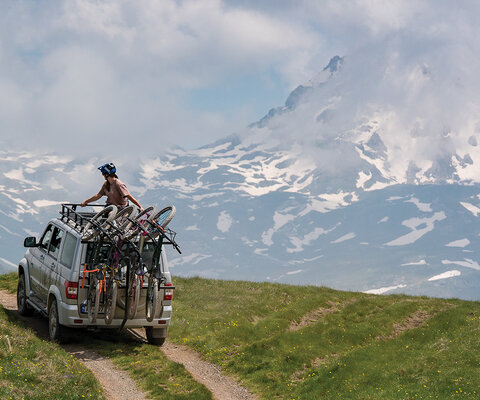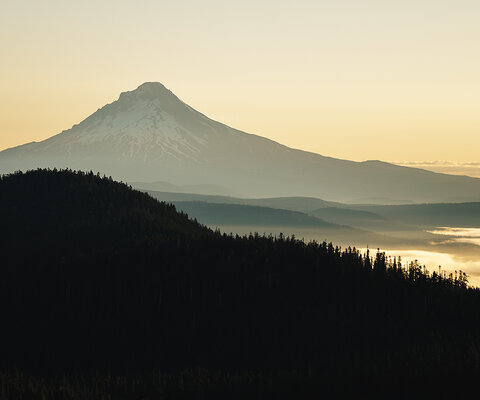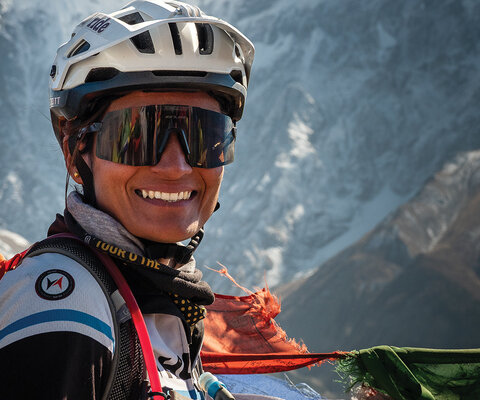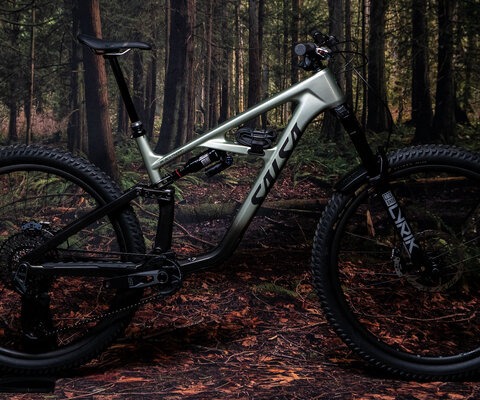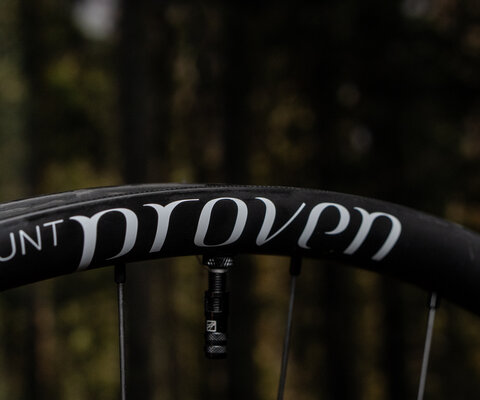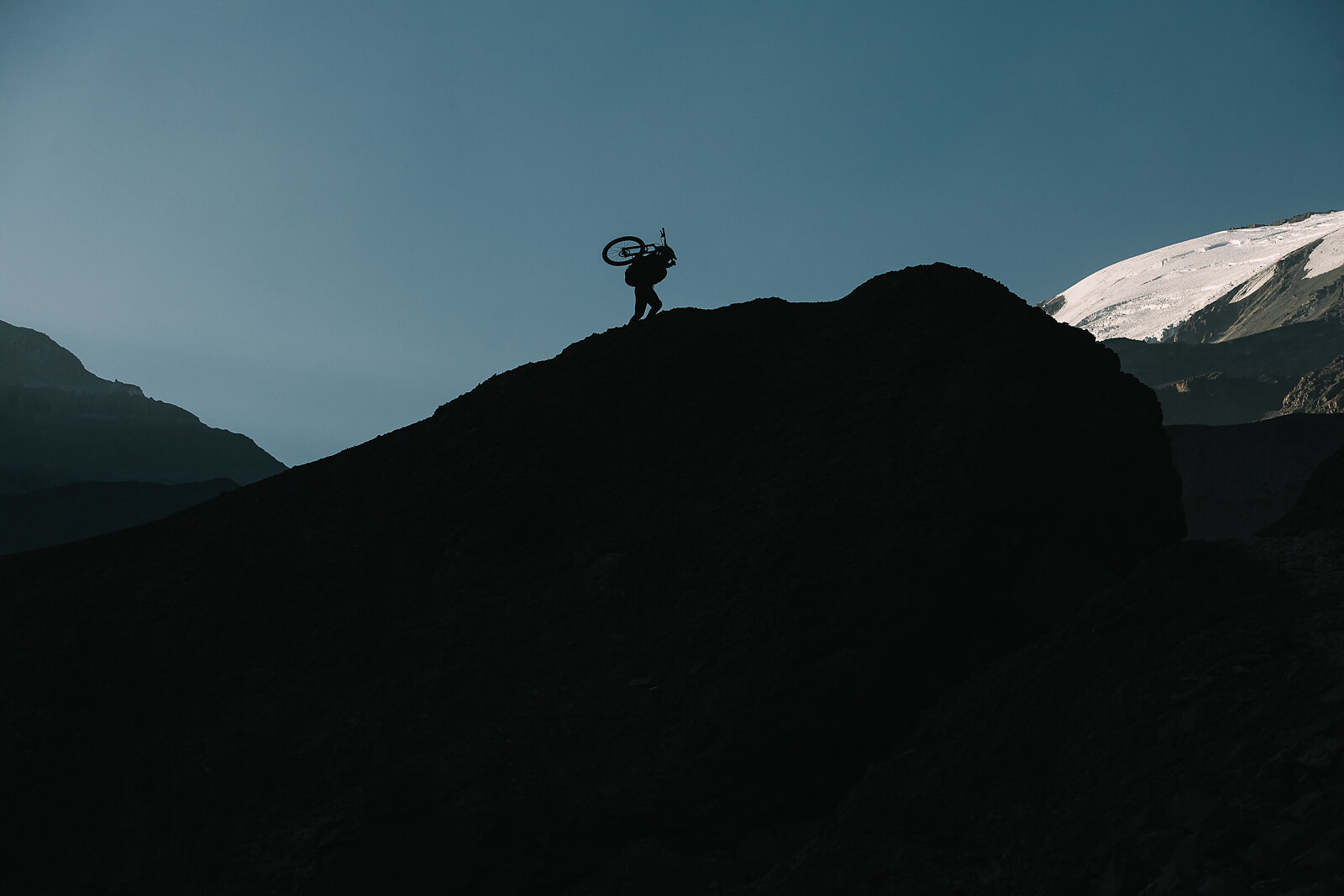
The Good, the Bad and the Foolhardy Chasing Shadows in Chile's Andean Highlands
Words by Brice Minnigh | Photos by Margus Riga
My eyes burned in the parching air as I squinted through blinding rays of midday sunlight at the imposing, snowcapped anvil that loomed above the immediate horizon. I paused to catch my breath, fixating on the broad, flat summit of Cerro El Plomo, its alluring upper reaches girdled in the grasp of a sprawling glacier.
For a moment, the spectacular sight made me forget about the nagging headache I’d been trying to ignore for the last few hours as I steadily pushed my bike through the boulder-strewn barrenness of the Central Andean highlands. It was a blissful reprieve, but within seconds the steady pulse that was pounding against my helmet straps reminded me of just how quickly we’d been gaining elevation on our first full day at altitude.
“I think we’re gettin’ close to the base camp,” I said, turning toward filmmaker Spencer Johnson, who was lying on the trail below, his head propped on the bulging camera pack he’d been lugging all morning. “And it looks like it’s gonna flatten out after that next corner.”
“I don’t know if I’ve got it in me,” Spencer sullenly replied. “I’m feeling lightheaded, and I’m out of water.”
There was no need to push our luck. This was just the beginning of a weeklong exploratory bikepacking traverse through a rugged stretch of the Chilean Andes. Together with photographer Margus “Raptor” Riga and professional freerider Kenny Smith, we’d come in search of unridden chutes—and to document our latest escapade in the niche realm of backcountry freeride. As longtime friends and adventure buddies, we also hoped to show what can happen when the Raptor, Kenny and I—three thrill-seeking mountain goats with a combined maturity level of the average teenager—convene in a far-flung location to test ourselves in a largely unfamiliar environment.
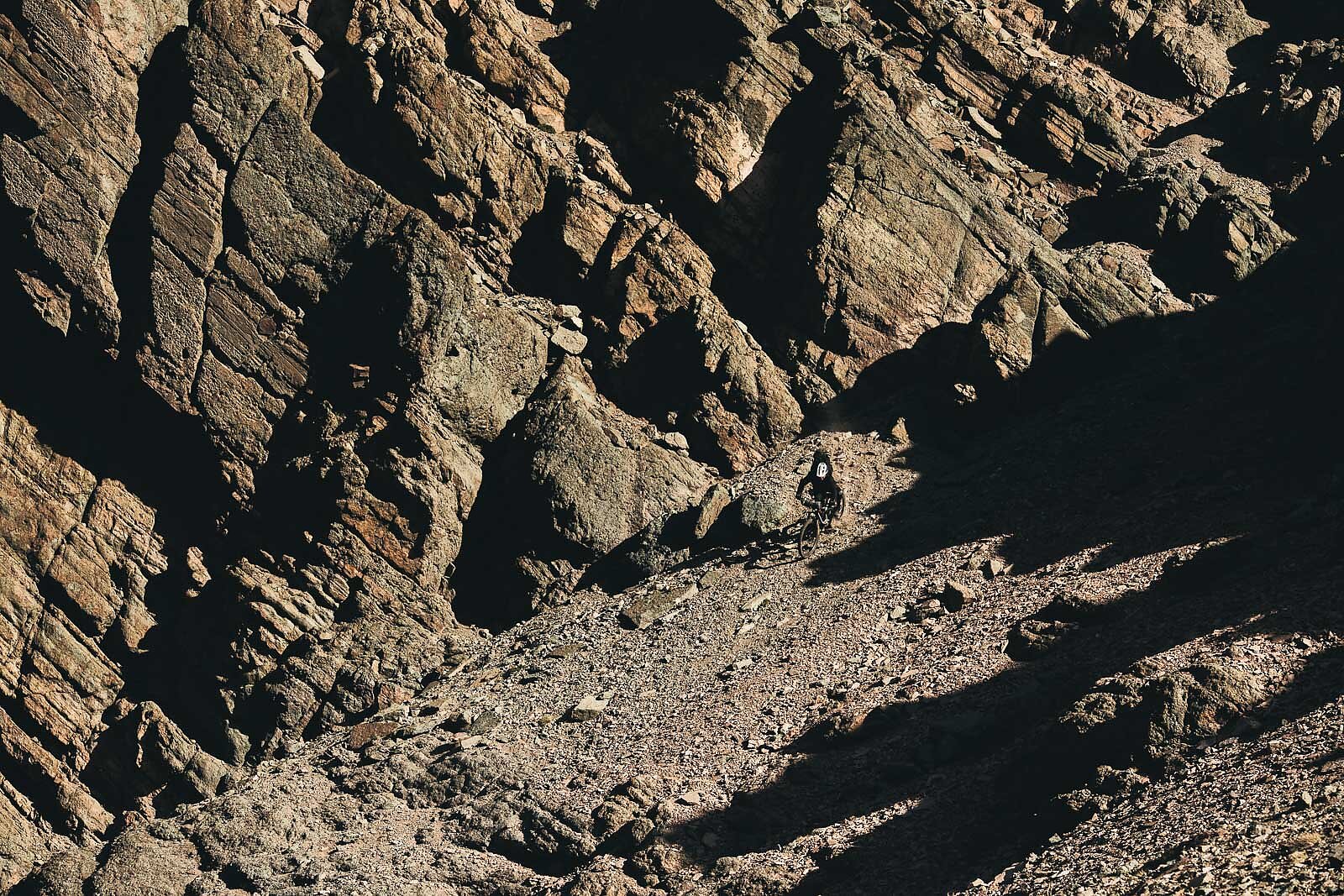
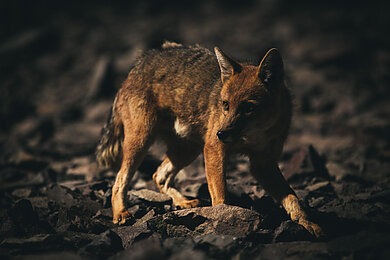
This scenario is a potent cocktail for misadventure. It typically leads to a sustained series of questionable decisions; a lively litany of juvenile dares, the answer to many of which is an unflinching “yes,” in spite of the consequences. And even though today’s agenda was simply an out-and-back scouting sortie to the mountaineering base camp of Plomo—mostly to acclimatize before descending back to our initial camp at a lower elevation—we were already falling into an all-too-familiar pattern. Namely, the Raptor was racing ahead of Kenny in a protracted game of cat-and-mouse, with me huffing steadily behind in an attempt to keep them in sight. This is our idea of a nice day out. But to the uninitiated, it could seem like pure folly.
“Why don’t you stay here for a bit while I see what’s past that next corner,” I told Spencer as I spotted Kenny’s slight figure emerging atop a pile of rocks. “I think they’re almost to the top.”
After another half-hour of disappointing false dawns, I finally crested the last ridgeline and stared across a vast plain that aff orded unobstructed views of Plomo and the adjacent Cerro Leonera. I pedaled along a meandering singletrack to a curious base-camp structure, where Kenny was watching Margus roll his celebratory cigarette. As we gazed at the ice-encrusted mountains, pondering the possibility of summiting them with bikes, Spencer appeared at the far side of the expanse. Despite his dizziness and a splitting altitude headache, he’d decided to persist with this perpetual game of chase.
“This is mini-golf,” Kenny quipped, mimicking the stilted motion of a short putt. “It’s only gonna get harder from here on out.”
As the words left Kenny’s mouth, an Andean fox trotted by, stopping at a safe distance to cautiously check us out. It was lean and fleet-footed, with a scrappy coat of copper-toned fur that underscored its hardscrabble existence in this sunbaked, reddish-brown landscape. The fox’s lonely life of foraging in this desolate dominion was certainly no round of miniature golf, but its fleeting presence was a harbinger of good things to come—starting with a rowdy descent down the trail we’d spent the last five hours pushing up.
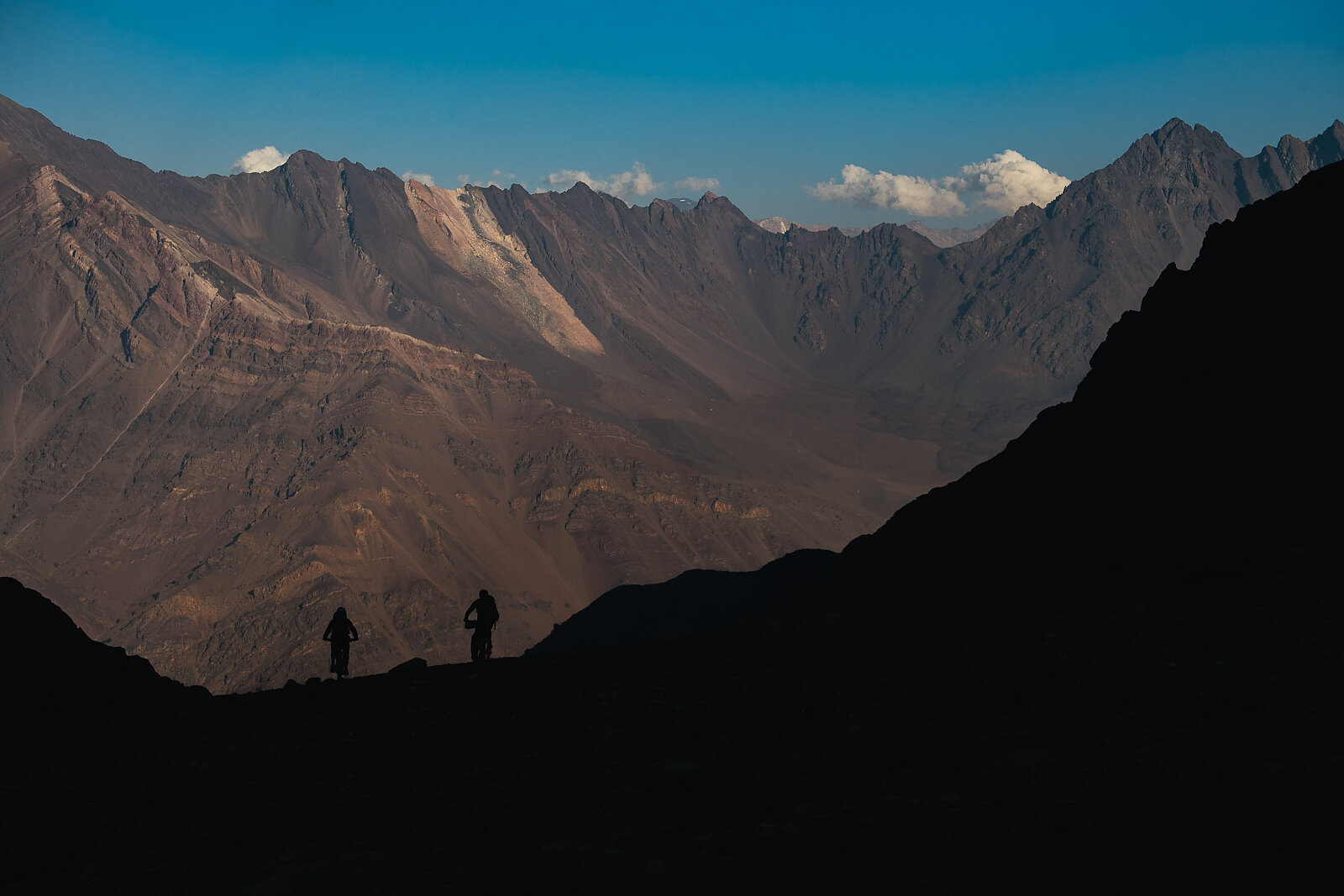
Kenny launched into an out-of-the-saddle sprint, quickly building enough speed to plow through the first jumble of off-camber rocks with ease. He was completely in his element, calmly slicing through the chunder and serving up massive roosts at every turn—often with an inside-foot-out savagery that even Sam Hill might envy. It was exciting to follow Kenny, but his ninja-like ability to stay rubber-side-down in this technical terrain was deceptive. I quickly fell prey to his illusion of ease. Just a few turns into the downhill, I skidded into a loose corner that sent me sideways as my heavy camera pack slung me straight to the ground with the fury of Hulk Hogan body slamming his opponent from the top of the ropes.
Just a few turns into the downhill, I skidded into a loose corner that sent me sideways as my heavy camera pack slung me straight to the ground with the fury of Hulk Hogan body slamming his opponent from the top of the ropes.
“I’m fine!” I yelled, jumping up and dusting the grit from my bleeding elbow. “But this angry midget is flinging me around like a rag doll.”
The awkward weight on my back was a valid excuse for my clumsiness, but Kenny’s pack wasn’t throwing him off his stride. On the contrary, it seemed to be a grounding force, helping him to counterbalance through tedious turns filled with scattered rocks. Even on the knife-edge of potentially fatal exposure, he remained perfectly composed, keeping his speed alongside a precipice that plummeted hundreds of feet to a glacial-fed river. A waterfall plunged into the narrow gorge below, its deafening roar disrupting my equilibrium. None of this fazed Kenny, who charged sight-unseen off a threefoot stepdown onto a sliver of trail that was scarcely wider than his handlebars.
This risky feat was scary to watch, but it was hardly surprising. For more than a decade, Kenny has earned a reputation for tackling stunts that make some of the world’s most fearless freeriders cringe with dread. It’s almost as if his fellow riders’ apprehensions are what fuel him to overcome his own worries. At times, talking Kenny off the ledge is tantamount to coaxing a suicidal tweaker from jumping off the Golden Gate Bridge, and he’s become notorious for defying warnings over near vertical rock rolls from the deserts of Utah to his former backyard playground of Whistler, British Columbia.

In recent years, Kenny has taken his penchant for danger farther into the wilderness, racking up first descents of scree slides all over his home province, from the steep walls that hem the Fraser River to never-before-contemplated slopes in remote corners of the Chilcotin Ranges. While other freeriders like James Doerfling, Kurt Sorge and Darren Berrecloth share the same affi nity for fall-line commitment, few attempt such lines while carrying the cumbersome loads necessary for unsupported bikepacking— which is exactly what this expedition was all about.
In recent years, Kenny has taken his penchant for danger farther into the wilderness, racking up first descents of scree slides all over his home province, from the steep walls that hem the Fraser River to never-before-contemplated slopes in remote corners of the Chilcotin Ranges.
Neither the Raptor nor I are strangers to the rigors of backcountry freeride, but our own experience couldn’t ward off the jitters that come when Kenny tries something unthinkable in the middle of nowhere. Though it was cold comfort, this time I’d brought along a well-stocked firstaid kit, complete with a SAM Splint and a satellite phone I could use to call a helicopter rescue. But as I watched Kenny tear through the treacherous sections that we’d struggled to walk up this morning, none of these emergency supplies could alleviate my concern for his safety. It wasn’t until we rolled into our camp on the smooth-stoned escarpment of Piedra Numerada that I could finally breathe easy.
As darkness fell over the valley, we prepared our freeze-dried meals and debated our plan of attack while trying to identify the stars that were rapidly illuminating into a dazzling canopy of constellations. We quibbled over whether Orion could be seen in the Southern Hemisphere in March as we contemplated the wisdom of attempting to cross a high-elevation ridgeline while Spencer was still acclimatizing. Nothing could be decided until morning, and I slept fitfully wondering what the next day would bring.
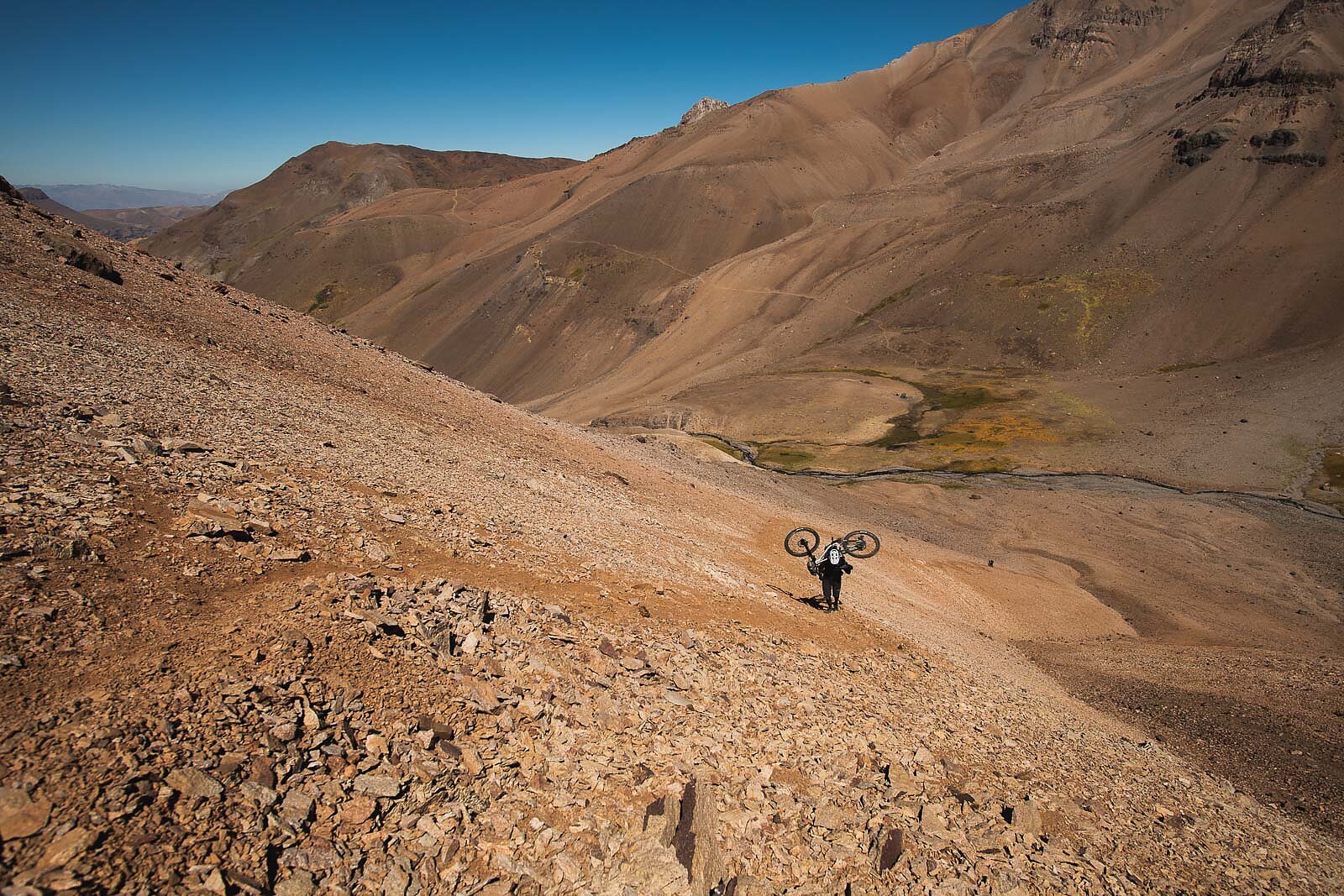
My questions were answered first thing, when Spencer woke me to say he was ready to tackle our first major pass. Our way up the mountain looked alarmingly steep, with only the faintest of sharply zigzagging lines to indicate the path of least resistance. Within an hour we were halfway up to the first ridge, but the top portion was so precipitous that progress was meted out in inches rather than feet. The only way to avoid backsliding was to anchor my wheels sideways above me and dig my toes into the rubble, one foot at a time, until I was close enough to once again hoist my bike up a few feet farther.
“This definitely ain’t mini-golf,” I said as I neared the ledge where the Raptor and Kenny were devouring some of their day’s rations.
“Nah, this is a full ‘hog,’ for sure,” Kenny agreed, employing his self-coined term for extreme hike-a-biking. “And this is what we call a ‘Canadian pit stop,’” he added as he and the Raptor stood up and started pushing again, leaving me to choke down my own snack and resume the race.
Ordinarily, I’d greet the “Canadian pit stop” joke with a laugh, treating it as merely the latest blow in the never-ending verbal sparring match between me, the Raptor and Kenny. But this time it felt slightly annoying, given that Spencer and I were carrying significantly heavier packs laden with essential video equipment. I’d become accustomed to trailing behind on backcountry missions over the years, but the weight disparity on this trip was making it all the more difficult to keep up.
Further adding to our handicap was the fact that the Raptor and Kenny had been taking altitude-acclimatization tablets known as Diamox for several days prior to our journey—something that Spencer and I had only learned of upon our arrival in Chile, when it was too late for us to effectively use the preventive medicine. This meant they were at scant risk of getting altitude sickness and could push themselves while gaining elevation, whereas Spencer and I needed to ascend in a more measured manner to allow our bodies to acclimatize naturally. It was not an even playing field, so the usual verbal jabs felt decidedly below the belt.
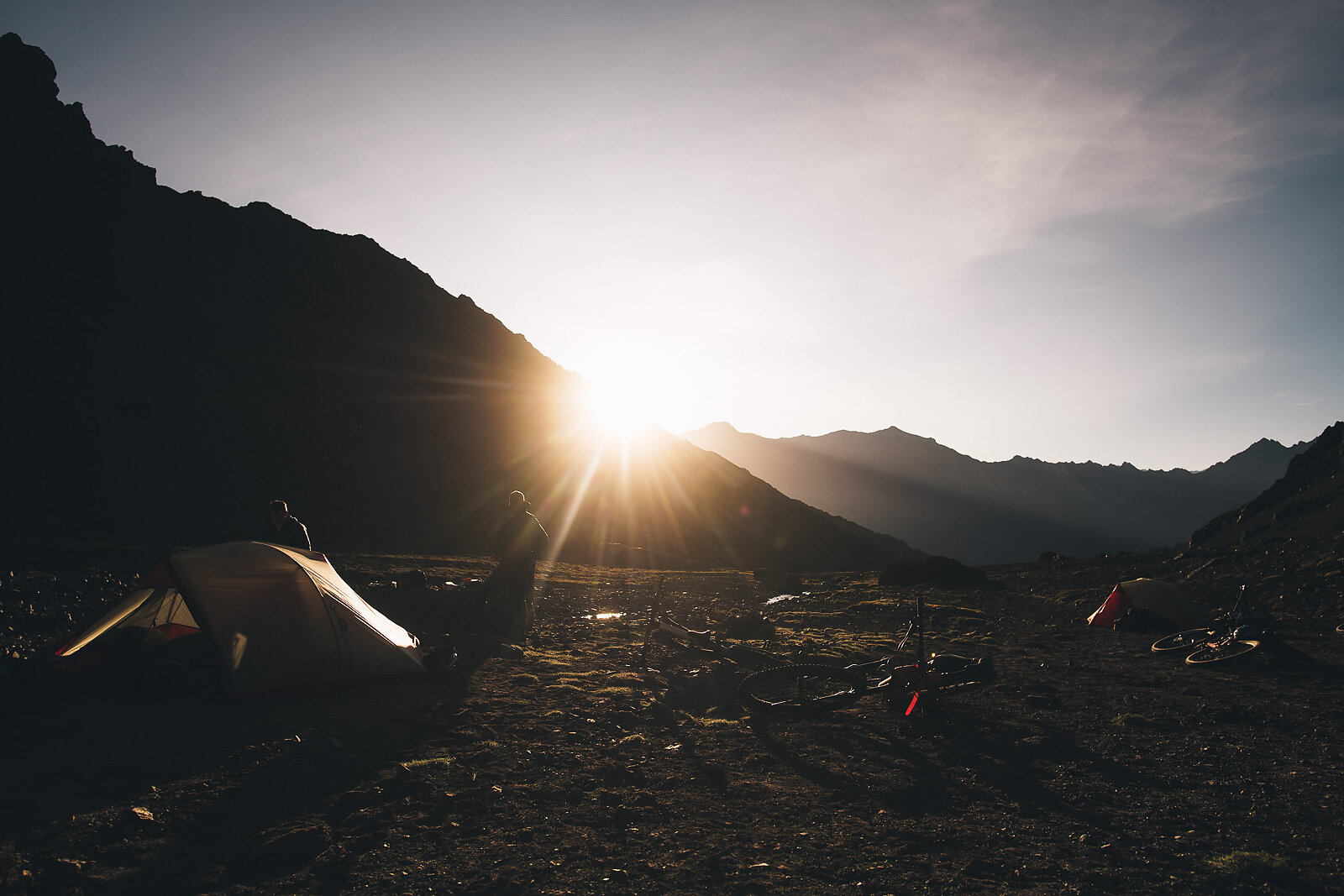
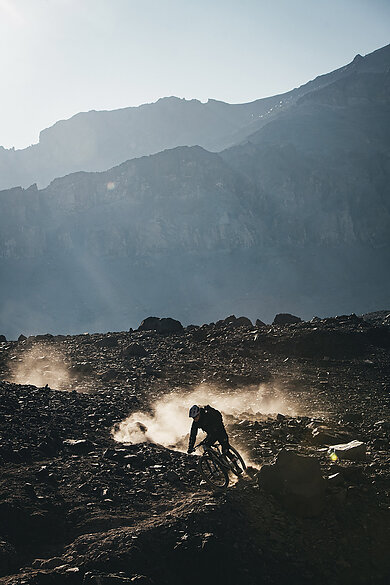
In this inhospitable arena, however, handicaps and excuses were irrelevant. The only thing that mattered was getting to the top of this 13,750-foothigh pass as quickly as possible to ensure we’d have enough light to make it down the other side by nightfall. By the time I joined the others at the top, Kenny had already plotted his course down the minefield of derailleur-destroying stone ordnance that separated us from the canyon floor below. Without hesitation, he dropped into the debris, setting off a mini rockslide that chased him down the hill. Before the torrent could overtake him, he dredged a huge left turn that sent him into a flume filled with finer fragments. Hell-bent on completing his line in one go, Kenny let out a war whoop and straightlined it all the way to the bottom.
We awoke the next morning headache-free, invigorated by a glorious sunrise and a rippable ribbon of primitive singletrack that crossed a series of minor spines. The gentle climbs, punctuated by short descents, allowed us to stretch our legs while gradually ascending to a flat outcrop overlooking a yawning river basin. A wide, multi-pronged waterway of mud-brown glacial melt bisected this burnt-orange depression, making for an intoxicating sight. Both sides of the canyon walls were stunningly sheer, peppered with ash-gray channels spilling into alluvial fans that lined the riverbank like a collection of gargantuan mollusk shells.
“This is what we came here for, boys!” Kenny shouted, pointing to the abyss below us. “It’s go time!”
He pointed his bike downhill and crept into the detritus, laying down a sequence of rear-wheel ski hacks before settling into a hypnotic rhythm of huge S-turns—narrowly missing thorn-filled shrubs that would have sent him tomahawking hundreds of feet. After 20 minutes of diagonal crisscrossing and semi-controlled wipeouts, I finally made it to the bottom, only to realize that we were but halfway down. Kenny and the Raptor, clearly stoked about the unexpected extension, had become specks in the distance, visible only by the plumes of dust they were leaving in their wakes. By the time I joined the others at an abandoned cowherder’s shelter near the river, the sun had slipped behind the jagged peaks above us.

I emptied the shale chunks from my shoes, inspected the cuts on my shins and headed to the river to fill a five-liter hydro bladder for filtering. Despite a rapid current, the water was still murky and replete with dark-brown sediment. As I sat quietly, pumping the filter and watching the sludge transform into a crystal-clear outflow, Kenny rode back into camp wielding a sizeable cow skull.
“This is one of the sickest cow skulls I’ve ever found,” he proclaimed as he pushed a wad of dried dirt from an eye socket. “I’m gonna take it home and add it to my collection.”
The next day, as we rode upriver in search of other rideable zones, we discovered that Kenny’s cow skull was far from unique. In the first few miles, we passed dozens of dead cows in varying states of decay. By midmorning, when the temperature was already pushing 100 degrees, the reason for this bovine carnage was evident: The valley, devoid of shade, was a veritable pressure cooker, and the high elevation made the sun all the more intense. I pondered why it was named the Valle del Río Olivares (Valley of the Olive Grove River). There were certainly no olive groves, much less any trees that could provide relief from the sun. I decided to rename it the Valley of Dead Cows.
The searing heat wasn’t the only pitfall. Much of the floodplain was saturated in standing water, making it marshy at best, and downright quicksand at its worst. Not only did this slow our progress, but it also made our continual game of pursuit a potential hazard. Spencer and I watched in alarmed amusement as Kenny followed the Raptor straight into an unmistakable bog, barely 200 feet from a partially decomposed cow, still standing in the quicksand where it had obviously died. We skirted the quagmire’s perimeter, laughing as we watched the competitive duo emerge from the muck.
“The shortest distance between two points ain’t always a straight line,” I joked as they stomped the gunk from their shoes.
With all the obstacles in our way, it was debatable whether we were going to achieve the day’s tentative goal: to size up a massive funnel of dark gray powder we’d spotted on the opposing canyon wall. Before we could get there, we’d need to cross the river, and we had yet to find a place shallow enough to allow safe passage.
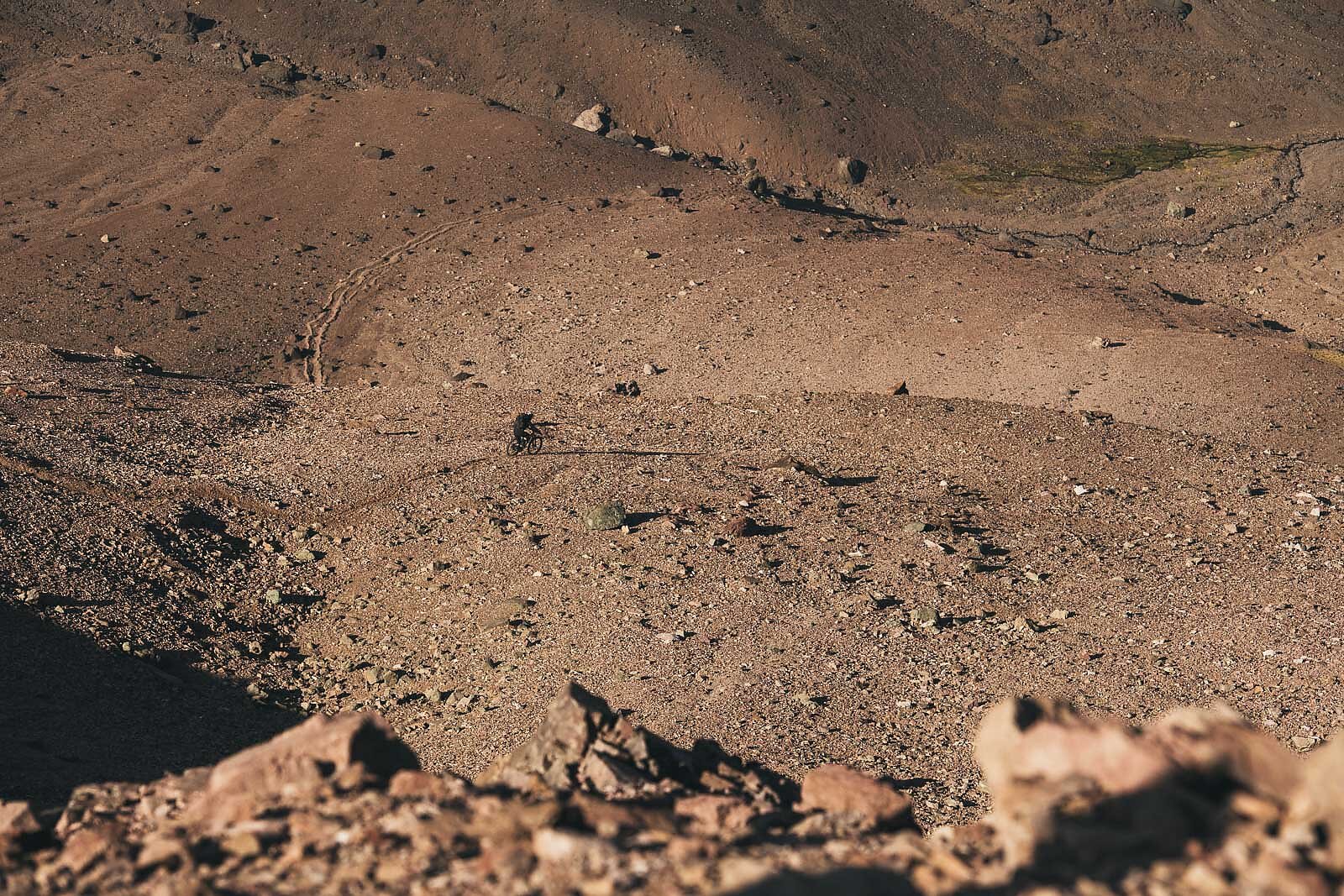
As entertaining as it was to throw rocks into the river, it wasn’t really helping us gauge its depth, so we elected to roshambo over who would be the guinea pig. Though delighted to see the Raptor’s rock-fist get covered in mine and Kenny’s paper-hands, we ultimately agreed this wasn’t a safe option, either. Deflated but not defeated, we continued upstream to scour our side of the ever-narrowing gorge. Much to our dismay, the spotty game trail we were schlepping up led us higher into rocky territory and farther away from the water source we would soon desperately need. Spencer and I signaled to the others that we were turning back, and by the time we reconvened at the roshambo point to replenish our water, the collective frustration was palpable.
It was true we were in hostile surroundings, baking in a convection oven of smelly cattle carcasses, on the brink of severe dehydration. But we did have water, and we were enveloped by some of the planet’s most majestic mountains.
While our hunt for epic fall-line rides had been a failure, I pointed out that the day was far from a waste. It was true we were in hostile surroundings, baking in a convection oven of smelly cattle carcasses, on the brink of severe dehydration. But we did have water, and we were enveloped by some of the planet’s most majestic mountains. We were in fine company, with practical jokes aplenty, and, perhaps most importantly, we were our own bosses. We were free to choose our own course, however foolhardy.
“We came here to seek the unknown,” I prattled in my best Forrest Gump voice. “And now we know what we didn’t know before.”
Even Kenny had to admit it. As crucial as our quest for the Holy Grail of First Descents was, the implicit beauty of these unsupported journeys was the freedom to fail, far from the stifling strictures of society. These trips were thinly veiled excuses to live like wild men, chew tobacco, swear like sailors and ride our bikes wherever we damn well please. All the suits of the world were confined to their air-conditioned cubicles, mindlessly taking orders from their superiors, while we were living large in the Andean hinterlands, reenacting scenes from The Good, the Bad and the Ugly. To succeed, all we had to do was make it to our final destination alive.
But if the hulking condors circling above us were any indication, at least a few of the locals had their doubts about our survival. To prove them wrong, we hopped on our rigs and rode downstream, setting up camp in the very place we’d slept the night before.
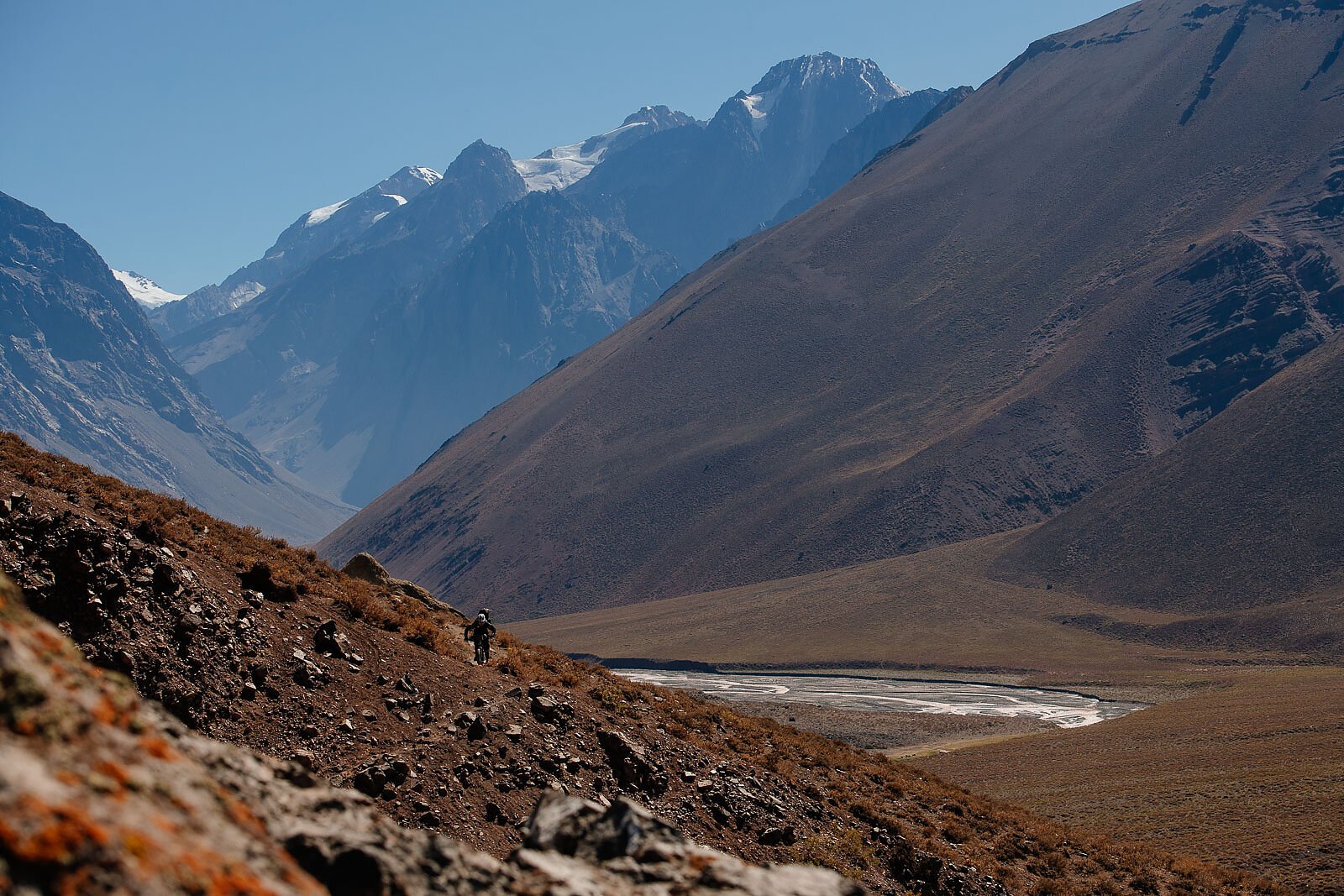
I crawled from my tent the next morning to feel a welcome element sweeping across my face. It was the wind, and it was blowing downriver, in the direction we needed to ride to reach our planned endpoint in the tiny village of El Alfalfal. Eager to capitalize on the tailwind, we hastily packed our bags and hit the animal trail. After an hour or so of smooth sailing, however, the wind shifted straight into us, compounding the difficulty of cleaning punchy climbs with a burdensome backpack. Adding to our struggle, the thorny bushes that lined the riverbank became denser as we gradually lost elevation. They grabbed my pedals and swatted my legs as if to punish me for trespassing on their turf. I reminded myself that this was part and parcel of Type 2 fun; it would make the memories all the sweeter once everything was said and done.

The rambling track eventually gave way to a rip-roaring descent down a hillside of half-buried babyheads before bottoming out at an unfinished hydroelectric dam. From here, a dirt access road trended downward through a deep gorge of towering cliffs for about 15 miles, ending abruptly at a T-junction with a gravel road. To the left, the road led back into the mountains to an area our map told us had hot springs. To the right, it wound down to El Alfalfal and bigger population centers beyond.
We were at the proverbial crossroads. And we had to decide whether to prolong our escape from civilization or return to the domain of humans, which we already knew was on the cusp of a global health pandemic. I checked our satellite phone for text updates, only to be met with conflicting advice.
“The coronavirus is getting out of control. You’re better off staying in the mountains,” read one.
“Chile is closing its borders tomorrow. You’d better get out while you can,” said another.
The devil was tapping one shoulder. The angel was tapping the other. But I couldn’t tell which was which. With only one more day of supplies, we thought of family, friends, fresh food and cold beer. Then we took the right-hand fork to humanity—and what we would come to know as the “new normal.”
